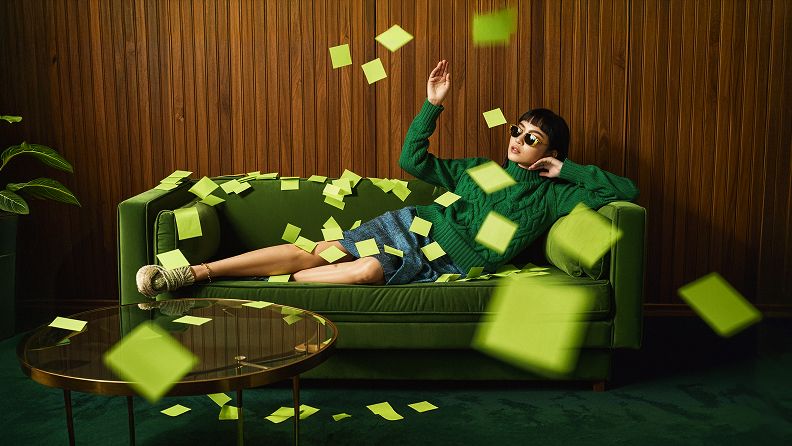6 Secrets for Working Effectively with Freelance Designers

Every day, more and more businesses are discovering the benefits of using freelance designers for some or all of their design needs. Working with freelance designers can offer an expert, agile and cost-effective solution that in-house recruitment and traditional design agencies struggle to match.
If you’re used to dealing primarily with an in-house team or those from non-design backgrounds, working with freelance designers can feel like a step into the unknown.
So, to ensure that your new relationship is a lasting and successful one, it’s important to understand the simple shortcuts to working most effectively with a freelance designer.
1. Communicate, Communicate, Communicate
This – to borrow a phrase – is the one rule to rule them all, the cornerstone from which everything else flows. From the moment you first make contact, until the design is delivered, it’s vital that you communicate clearly and effectively with your designer.
Of course, that isn’t unique to working with designers. The same is true of any working relationship. But the fact that the designer is likely to be working remotely and largely independently, it’s even more important that such communication happens.
One-to-one conversations will often be the best way to communicate, but technology means it needn’t be the only way. How you do so – whether via Skype, WhatsApp, Slack or something else – is up to you and your designer. But the reasons for, and importance of, communicating remain the same.
2. Set Your Frame
Among other things, effective communication with your designer helps avoid misunderstandings or incorrect assumptions. And nowhere is this more evident than at the outset of a project, when you set the parameters of how and what you want.
Think of it as creating the walls of your designer’s “playpen” and the rules that govern it. Or as marking out the frame within which they can express their creativity.
So, before you set your designer off to work, it’s vital that both you and the designer are clear on:
- Scope
What do you want delivered? What aspects will you provide or manage yourself? Of course, there may be aspects that necessarily remain fluid – that’s not an issue, just as long as you and the designer are clear about what those are and if, and when, they will be determined.
Also, once scope is set, try to avoid later changes or “scope creep.” Sometimes it’s unavoidable, but just be aware that it’ll likely mean added costs, both in terms of time and money. - Budget
Understand how your freelancer charges for their work (hourly vs. fixed rate, etc.), and agree with them how, when and what they’ll be paid, and what will happen in the event of any delays or variations in scope.
And just to note, if the price you are quoted seems high, don’t assume that it’s the designer trying to pull a fast one. A designer’s hourly rate will generally have been earned based on their expertise and experience. What’s more, just because a project is easy to describe (“design a homepage for my website”) doesn’t mean that, from a design point of view, it’s either easy or quick – or, indeed, cheap. - Timing
What is the ultimate deadline for the project? When will intermediate drafts be delivered? What will the turnaround time for review be?
These may seem like tiresome details, but locking them down at the outset is the best way to avoid problems and delays further down the line. - Other constraints, drivers, etc.
Where will your logo appear? Will your presentation also need to be printed in black and white? Are there legal or other restrictions on what your website must or mustn’t say?
Again, these can feel like needless minutiae. And it might not be possible to think of every last detail at the outset. But the more that you can set them out before you start, the better sense the designer will have of the “frame in which they can paint.”
And, in turn, the more confident you can be that what they deliver will be fit for purpose.
Particularly if your design needs have various discrete elements or involve a team of freelancers, conveying this information can feel burdensome. But it is worth the effort. And increasingly, freelance design services like Superside now offer a layer of coordination and project management between you and each individual freelancer, taking much of the strain off you and leaving you with a single point of contact to deal with.
3. Say What You Want to Achieve, Let Your Designer Show You How
There’s a reason you’re hiring a designer. And most likely it’s because they have more design expertise and experience than you. So you need to trust them, and let them do their job.
That’s why, rather than describing to the designer exactly what (you think) they should deliver, instead tell them what you’re trying to achieve or the problem you’re trying to solve.
Do you want to evoke a particular emotion? To make your logo stand out as different when shown alongside your competitors? Or to get users to navigate to a portion of your website that they’re currently skirting around? Those are the sorts of insights that allow a designer to use their expertise to find solutions to the problems you face.
If you take your car to the garage, you tell the mechanic that the engine’s rattling or that you want to improve its fuel efficiency. You don’t hand her a diagram of how to replace a carburetor…
And once you’ve set the “problem,” trust them to find the solution.
If they’ve chosen a particular way of doing things, it’s because they know it’s what works – what delivers the best user experience – it’s not that they’ve found a new design tool on Adobe Illustrator and just really want to play around with it.
That’s not to say that you can’t have ideas for what you want, of course, but deliver them early in the process. (A designer would rather hear them upfront than once they’ve already produced a draft.)
Remember that design ideas are about inspiration, not imitation. “Make it look like my competitor’s site” is both unhelpful and, if followed through, probably illegal.
Instead, think about the colors, styles or phrases that resonate with you or that embody your business, and why. For example, many people find mood boards, word clouds and the like to be a simple, effective way of gathering ideas (including from across a business) for the designer to use. A designer will likely appreciate something like this rather than reject it – again, it gives him or her a sense of the parameters within which they can express their creativity.
Unlike, say, a math equation with a definite right or wrong answer, design isn’t black and white. There will always be subjectivity involved. Simply put, tastes differ. And designers recognize that too. But there is such a thing as “good design” and “bad design” – trust your designer to know that difference, and you’re on to a winner.
4. Understand How Designers Think
As with any specialist profession, designers have a seemingly endless list of technical words, acronyms and phrases that can seem like a foreign language to the rest of us: think golden ratios, CMYK, kerning and more.
You certainly don’t need to learn all of these – indeed, part of a designer’s role is to explain what they’ve done or plan to do in a way everyone can understand – but it can still be useful to familiarize yourself with a few of the main concepts.
Just as important as understanding what designers say is understanding how they think.
To you, the success of a website might be all about the number of hits it gets or whether it complies with certain regulatory disclosure obligations.
But from a designer’s perspective, user experience will be key. Expect them to look at things from the point of view of a consumer browsing your site or viewing your presentation “from the bleachers.”
That’s not to say that metrics like hit rates aren’t relevant, but they tend to flow from a good user experience. Without the latter, you’ll struggle for the former.
5. Bring Your Designer Into the Fold
Business people often say that a real benefit of freelance designers is that they’re used to working independently – they know how to take an idea and proactively run with it.
But that doesn’t mean that you should keep a freelancer entirely remote from your business.
Particularly if you have an existing in-house design team that the freelancer is supplementing or a wider freelancer pool, think about how you might bring the designer “into the tent” and make them feel part of a wider collective effort. That might mean having them join internal team calls, adding them to internal chatgroups, participating in private calls, or helping them understand your business’ culture.
Not only can this make a freelancer feel more valued and avoid some of the difficulties that can arise when working relationships are entirely “faceless,” but the insights they gain into how your business works and the things it values can also offer the designer important guidance and inspiration for your projects.
6. Feedback: Give it Right, Give it Often
Providing feedback to a designer is no different from providing feedback to any other employee: the key is that it’s targeted, specific and timely.
As mentioned earlier, it’s always worth agreeing upfront with your designer when and how feedback will be given – while regular, iterative feedback may feel more time-consuming for you, it is far easier to address issues and implement changes as you go than to end up being presented with a final draft that doesn’t meet your needs.
This isn’t about micromanaging (designers hate that as much as the rest of us), but it’s about making sure that you and the designer remain on the same page at all stages of the work.
So don’t just tell your designer that you don’t like something – explain why. Hot tip: “Can you give it more of a ‘wow factor’” is not the sort of feedback that a designer can do much with.
Designers want you to be honest, and constructive feedback is likely to mean a better end product. But be aware of how that feedback is given. The highly involved, collaborative nature of the designer-client relationship puts a premium on maintaining good working relations. If, due to the way feedback is given, rather than its content, those relations start to strain, it risks – in the worst cases – undermining the relationship altogether.
And where possible, try to ensure that – even if several people are reviewing drafts – feedback is provided to your designer in an ordered way and through a single point of contact. This will help avoid comments getting accidentally missed in a flood of messages and help prevent the designer getting contradictory comments from different sources – a bugbear for designers and a frequent source of confusion and delay.
Last but certainly not least, remember that the feedback and reflection process doesn’t have to end when the final product is delivered. Particularly if you might work with the designer again in the future, take time to look back at the project with them (and/or the project manager) and reflect on what went well, what could have gone (even) better, and what you’ll do different next time.
And that’s it – six simple steps to a long and happy design romance.
You may also like these

Comparing the Top 10 Outsourced Design Services in 2025: Which One is Right for You?
Struggling to get high-quality designs from a design team already at capacity is frustrating. Layer on ad-hoc requests and the design team's own projects fall apart and team morale sinks.It doesn’t have to be this way. Many companies will take on the overflow, add that missing skill, or work through the tireless monotony of ad variations—they're available in three different options: Option 1. Hire a freelancer or agency. You can outsource the overflow to a freelancer marketplace or an agency. But you don’t need more work onboarding, managing, and spending countless hours buried in administrative work with freelancers, nor do you want the fear of submitting the expensive bill to your boss from a slow agency.Option 2. Hire in-house. Hire more in-house talent, which comes with all of the added costs and responsibilities of recruitment, onboarding and employee retention.Option 3. Subscribe to an outsourced design service. To scale design efficiently and discover unique design skills, you can partner with a creative design subscription service to get great design work done on-demand.
Maximizing Profit: The Impact of Design on Business Strategy
Design has never been more in demand. As the first interaction for most customers with businesses, it’s just everywhere—from the homepage of your favorite website to the product packaging your new sneakers arrived in.With smartphones, tablets and digital interfaces at every turn, every design element now affects nearly every consumer touchpoint during the customer journey.That’s why the smartest companies are investing in good design systems for all their inputs—and for a good reason: It’s good for the bottom line.A 2018 McKinsey report, “The Business Value of Design,” put the impact of design on your bottom line with data: Over five years, companies that invested in good design had 32% more revenue and 56% more total returns to shareholders.Is your company investing enough in design? Read below data-driven insights and historical examples from visionary leaders who used powerful designs to communicate value to their target audience—and why you should start to do it too for every asset you have.
The Ultimate 5-Step Graphic Design Process
For any design team, having an established graphic design process will lead to better designs, higher output and most importantly, remove a lot of potential frustration.The process of starting a graphic design project has changed drastically over the years. Now, AI-powered design is the driving force behind concept development and the design thinking process, which makes it necessary to think about the different perspectives infused into each design stage.If you’re leading graphic designers or looking to streamline the process, then let’s take a look at the 5 most essential steps of the graphic design process.The Importance of a Structured Design ProcessGraphic design is an intricate blend of creativity and strategy, requiring a structured approach to ensure that the final product not only looks stunning but also effectively communicates the intended message.







